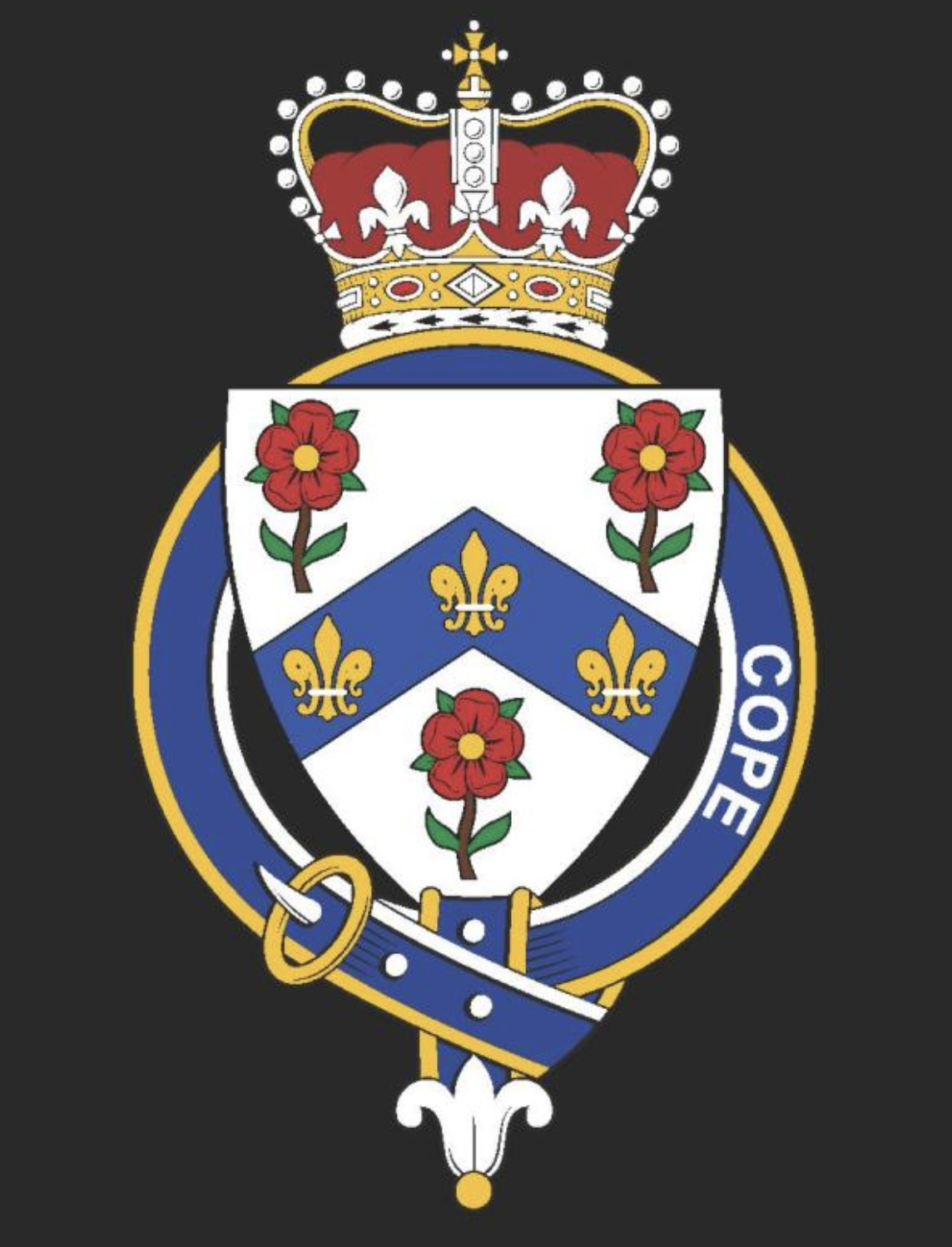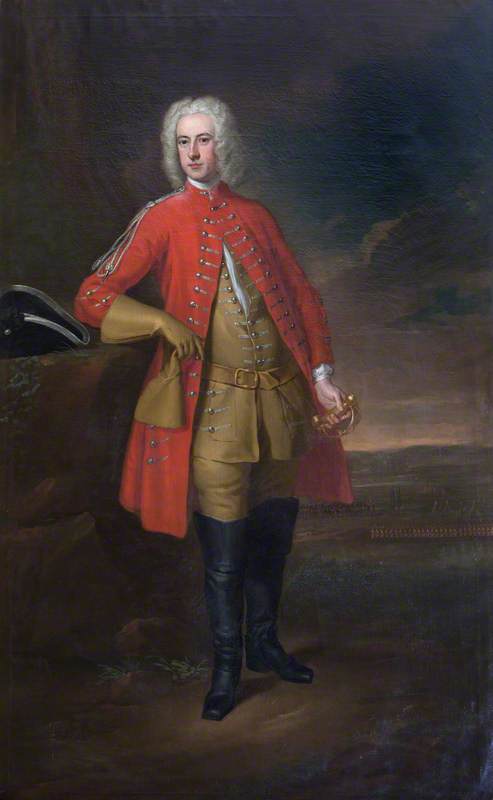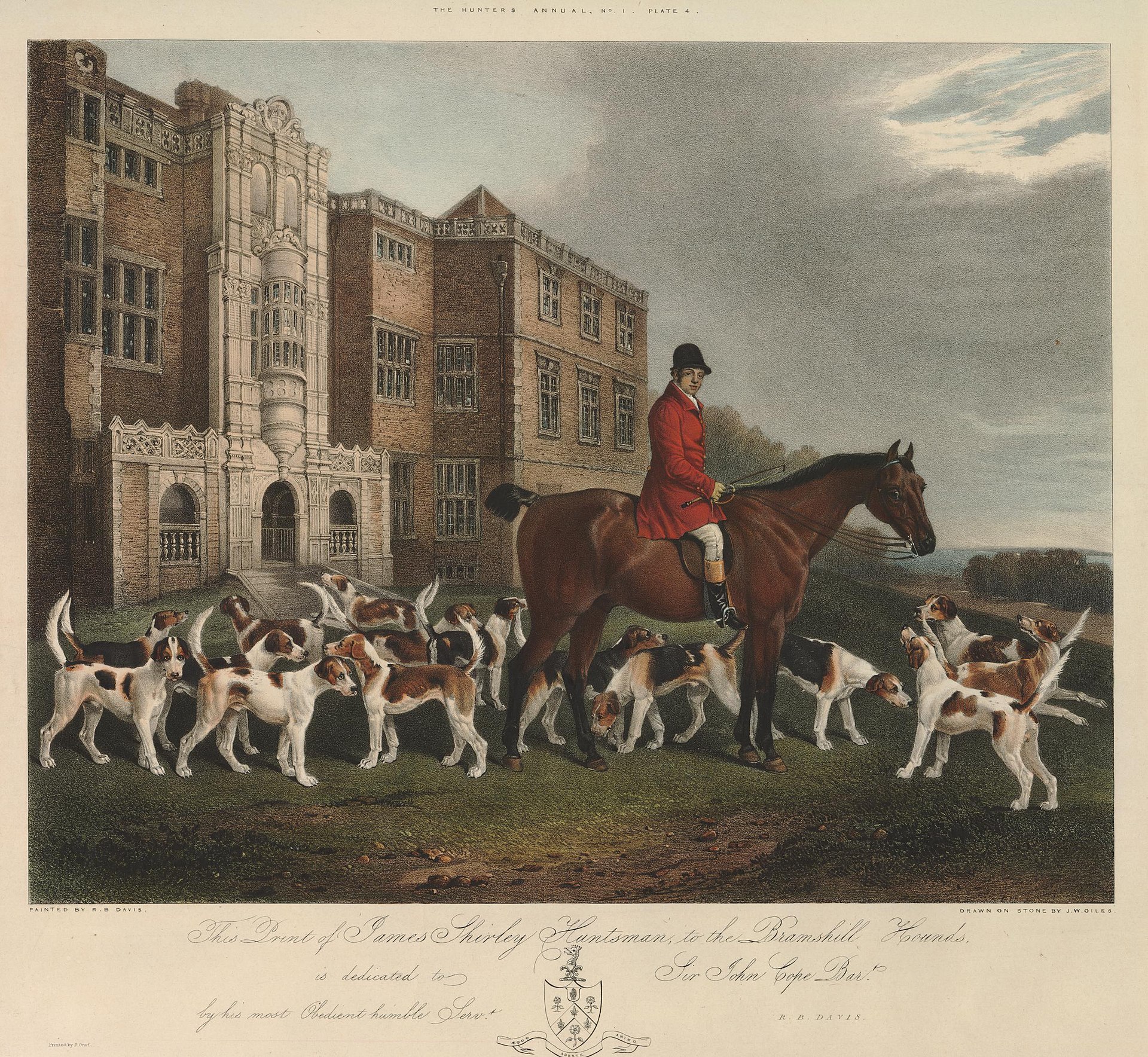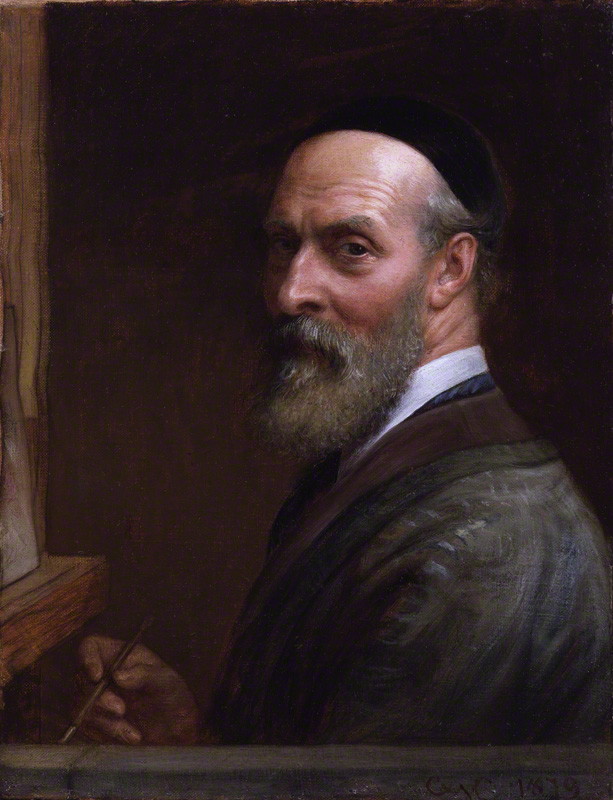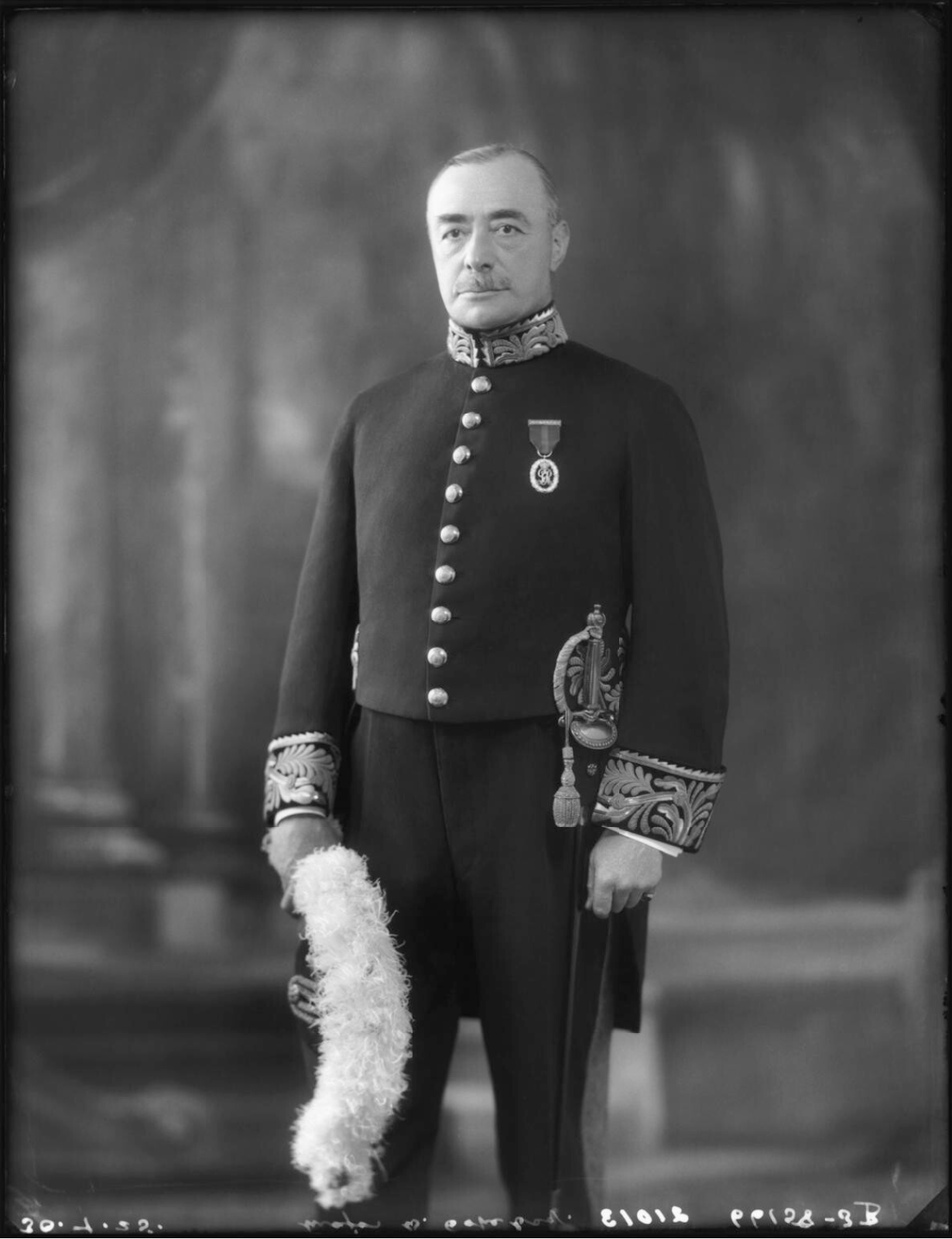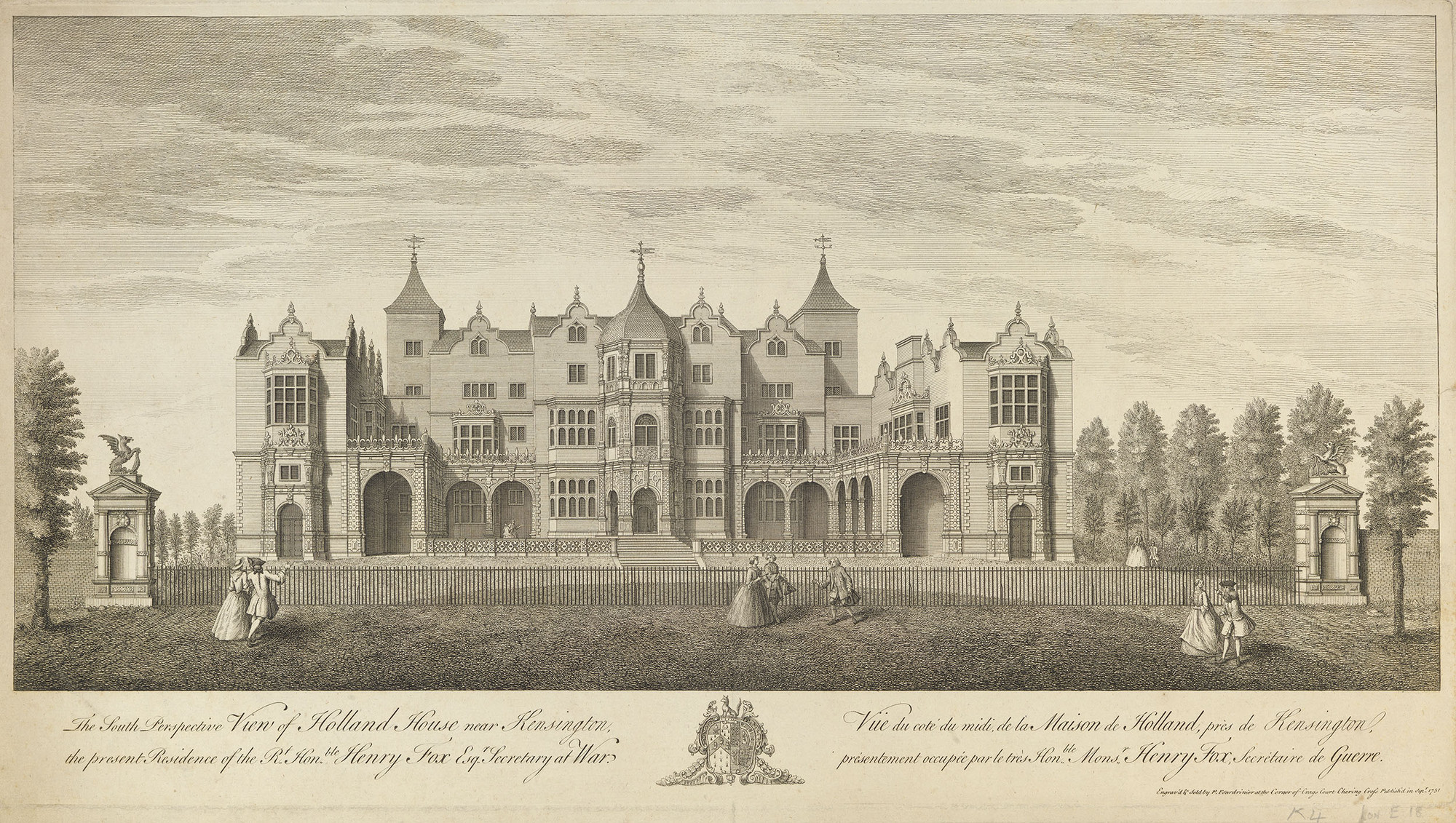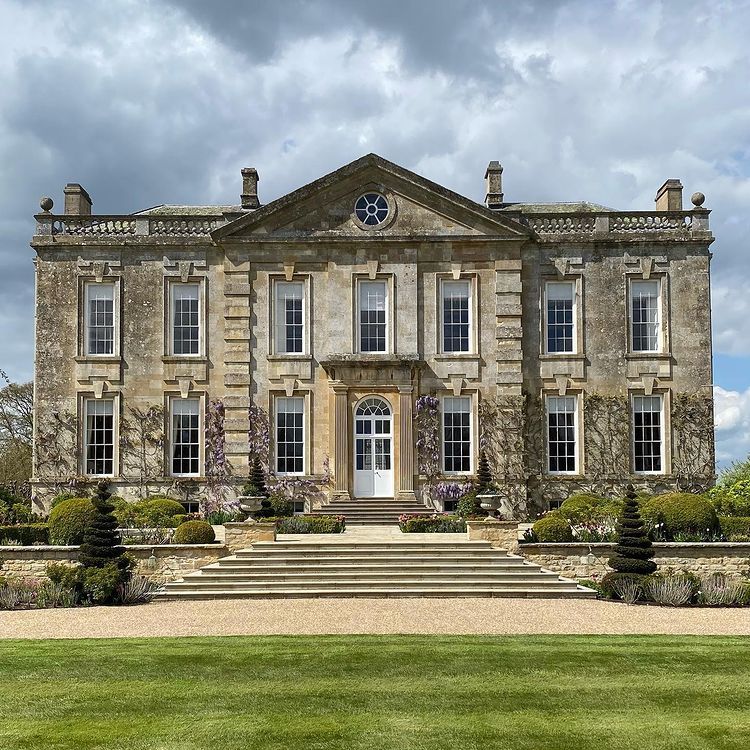House of Cope
Contents
House of Cope
The earliest origins of the Cope surname date from the ancient Anglo-Saxon culture of Britain. Their name reveals that an early member was a person who habitually wore a long cloak or cape. The surname Cope is derived from the Old English word cope, which emerged about 1225 and comes from the Old English word cape, which refers to a cloak or cape.
The House of Cope is an English and British noble and aristocratic family, which hails from Banbury, Oxfordshire. Family members have served as Members of the Royal Household, Members of the Privy Council, Members of the House of Commons, diplomats, bankers, merchants, government officials, academics, and authors.
The Cope family began its rise during the Tudor period by serving King Henry VII, King Henry VIII, Queen Mary I, and Queen Elizabeth I. The Cope family influenced the English economy and international trade.
The family motto in the Latin language is Aequo - Adesto - Animo (eng. Be present with mind unchangeable).
Background
The surname Cope was first found in Northamptonshire and Buckinghamshire where the family "appear in the character of civil servants of the crown in the reign of Richard II and Henry IV, and were rewarded with large grants of land."
The first prominent member of the family was John Cope of Deanshanger (d. 1415) who was Member of Parliament for Northants (currently known as Northamptonshire) in 1397.
The earliest known members of the Cope family rose when England was ruled by the House of Lancaster but it rose to prominent positions during the Tudor period by serving the King of England Henry VII and King of England Henry VIII.
Sir William Cope PC was the Cofferer of the Royal Household for the King of England Henry VII and Keeper of the Porchester Castle.
Sir William's father was Stephen Cope, his grandfather was William Cope, and his great-grandfather was John Cope MP for Northants.
Sir William Cope PC married Agnes Harcourt, the daughter of Sir Robert Harcourt. Sir William's second wife was Jane Spencer the daughter of Sir John Spencer of Hodnell. Sir William had several children with Jane Spencer. Sir William sold the lordships of Wormleighton and Fenny Compton to the Spencer Family, later Althorp.
Diplomat Sir Walter Cope started to build the Cope Castle in 1605 and finished in 1607. Architect John Thorpe designed the building. Cope Castle was renamed Holland House because Sir Walter Cope's daughter Isabel Cope married Henry Rich, 1st Earl of Holland. During its history, Holland House became a salon for prominent figures. Lord Byron, Charles-Maurice de Talleyrand-Périgord, Thomas Babington Macaulay, and Madame de Staël dined at the house. Holland House was heavily bombed during WWII. The remains of the Holland House are in Holland Park, Kensington, London.
According to Martha Hiden: "He (Sir Walter Cope) was one of the leaders of his time in creating and developing England's foreign trade." Cope owned the Custom House Quay in the City of London. Cope was an investor in new joint-stock companies.
Sir Anthony Cope was knighted by the Queen of England and Ireland Elizabeth I in 1590. He was also made the 1st Baron of Hanwell by the King of England, Ireland, and Scotland James I in 1611.
Notable Members
John Cope of Deanshanger (d. 1415), Member of Parliament for Northants
Sir William Cope PC (d. 1513), Keeper of the Porchester Castle, Constructor of Hanwell Castle, Cofferer of the Royal Household of King Henry VII, Member of the Privy Council
Sir Anthony Cope (1486-1551), Author, Sheriff of Oxfordshire and Berkshire, Vice-Chamberlain and Principal Chamberlain to Queen Consort and wife of King Henry VIII Catherine Parr
Dr Alan Cope (d. 1578), Author, Senior Proctor at the University of Oxford, Fellow at Magdalen College at the University of Oxford, Master of Arts, Native of the City of London
Sir Walter Cope (1553-1614), Constructor of the Cope Castle in London, Gentleman Usher of the Privy Chamber for King James I, Master of the Court of Wards, Chamberlain of the Exchequer, Registrar-General of Commerce, and Member of Parliament for Westminster
Sir Anthony Cope (1550-1615), 1st Baronet of Hanwell, Sheriff of Oxfordshire, Member of Parliament for Banbury and Oxfordshire
Sir William Cope (1577-1637), 2nd Baronet of Hanwell, Member of Parliament for Banbury and Oxfordshire, Sheriff of Oxfordshire, Member of Lincoln's Inn
Sir John Cope (1608-1638), 3rd Baronet of Hanwell
Sir Anthony Cope (1632-1675), 4th Baronet of Hanwell, Member of Parliament for Banbury and Oxfordshire
Sir John Cope (1634-1721), 5th Baronet of Hanwell, Member of Parliament for Banbury and Oxfordshire, Owner of Bramshill House in Hampshire
Sir John Cope (1673-1749), 6th Baronet of Hanwell, Commissioner and Director of the Bank of England, Whigs Member of Parliament for Plympton Erle, Tavistock, Hampshire, and Lymington
Sir John Cope KP (1688-1760) Whig MP for Queenborough and Liskeard, Governor of Limerick, Commander-in-Chief in Scotland, Lieutenant General
Sir Jonathan Cope (c. 1690-1765), 1st Baronet of Bruern, Tory Member of Parliament for Banbury, Owner of Hanwell Castle, Owner of the ground at the Custom House in the City of London
Sir Monoux Cope (1696-1763), 7th Baronet of Hanwell
Edward Cope Hopton (1708-1754), Tory MP for Hereford
Sir John Mordaunt Cope (1731-1779), 8th Baronet of Hanwell
Sir Richard Cope (1719-1806), 9th Baronet of Hanwell, Chaplain to the Speaker of the House of Commons
Sir Charles Cope (1743-1781), 2nd Baronet of Bruern, Sheriff of Cambridgeshire and Huntingdonshire
Sir Jonathan Cope (c. 1758-1821), 4th Baronet of Bruern
Sir Denzil Cope (1766-1812), 10th Baronet of Hanwell
Sir John Cope (1768-1851), 11th Baronet of Hanwell
Sir Charles Cope (c. 1770-1781), 3rd Baronet of Bruern
Charles West Cope RA (1811-1890), Victorian Era Painter, Professor of Painting, Academian at The Royal Academy of Arts in London, Silver Medal from the Royal Society of Arts, Manufactures and Commerce in London
Sir William Henry Cope (1811-1892), 12th Baronet of Hanwell, Rector of Easton, Author of Bramshill - Its History and Architecture (H.J. Infield, 1883)
Thomas Cope (1827-1884), Tobacco Manufacturer, Founder and Owner of Cope Bros & Co., Founding Member and the First Speaker of the Liverpool Parliamentary Debating Society
George Cope (1822–1888), Tobacco Manufacturer, Founder and Owner of Cope Bros & Co., Owner of the Dove Park (Reynolds Park) in Liverpool
Sir Anthony Cope (1842-1932), 13th Baronet of Hanwell, Lieutenant colonel
Sir William Cope (1870-1946), 1st Baron Cope, Conservative Member of Parliament for Liandaff and Barry, The Comptroller of the Household, Master of Arts, Clare College, University of Cambridge
Sir Denzil Cope (1873-1940), 14th Baronet of Hanwell
Sir Anthony Mohun Leckonby Cope (1927-1966), 15th Baronet of Hanwell
Joan Penelope Cope (1926-1991), Author of Bramshill - Being the Memoirs of Joan Penelope Cope (1938), Daughter of Sir Denzil Cope, 14th Baronet of Hanwell, Lady Grant, Wife of Sir Duncan Alexander Grant, 13th Baronet of Dalvey
Sir Mordaunt Leckonby Cope (1878-1972), 16th Baronet of Hanwell
Lord John Cope MP, Baron Cope of Berkeley (1937-), Opposition Chief Whip of the House of Lords, Paymaster General, Treasurer of the Household, Conservative Member of Parliament for Northavon and South Gloucestershire, Member of the House of Lords
Family Estates
Firstly Baronets of Hanwell lived at Hanwell Castle but then they moved to Bramshill House in Hampshire. Baronets of Bruern remained at Hanwell Castle, Tangley Hall, and Bruern Abbey in Oxfordshire.
The Cope family held lands in Notts, Derbys and Essex and also in Hardwick, Hanwell, Drayton, Bruern and Tangley.
Hanwell Castle in Oxfordshire
Hanwell Castle in Banbury, Oxfordshire was the seat of the Cope family for several centuries. It has hosted English Kings and Queens.
The construction work of the Hanwell Castle began in 1498 by William Cope. Sir Anthony Cope completed the Hanwell Hall. It had four towers and a gatehouse. The “gallant house of Hanwell.” It was a spacious quadrangular building, with massive towers at the angles.
King of England, Ireland, and Scotland James I made royal visits to the Hanwell Castle in 1605 and 1612. King James' visit was hosted by the 1st Baronet of Hanwell, Sir Anthony Cope. King of England, Ireland, and Scotland Charles I visited Hanwell Castle in 1637. King Charles' visit was hosted by the 2nd Baronet of Hanwell, Sir William Cope.
Sir Anthony created a beautiful garden for the estate.
Members of the Spencer family lived at the castle.
Copes lived at Hanwell Castle until 1714 but the Copes owned it until 1781. 4th Baronet of Bruern, Sir Charles Cope was the last owner. The estate was in a good condition in the 19th century. During the late 19th century the estate gradually decayed.
Kellogg College, University of Oxford, has practised excavation at the estate. Hanwell Castle is a Grade II-listed building.
Many members of the Cope family are buried at St. Peter's Church in Oxfordshire.
The Cope Castle (Holland House) in Kensington, London
Diplomat Sir Walter Cope started to build the Cope Castle in Kensington, London, in 1605 and finished in 1607. Architect John Thorpe designed the building. Cope Castle was renamed Holland House because Sir Walter Cope's daughter Isabel Cope married Henry Rich, 1st Earl of Holland. During its history, Holland House became a salon for prominent figures. Lord Byron, Charles-Maurice de Talleyrand-Périgord, Thomas Babington Macaulay, and Madame de Staël dined at the house. Holland House was heavily bombed during WWII. The remains of the Holland House are in Holland Park.
Bruern Abbey in Oxfordshire
Sir Anthony Cope bought the Bruern estate after 1610. The Bruern Abbey, a Baroque palace, in Oxfordshire was constructed for Sir John Cope (1688-1760) around the 1720s. The architect of the building is highly likely Oxford mason William Townsend. Townsend left his mark on Blenheim Palace, which is nearby.
Tangley Hall in Oxfordshire
Anthony Cope's son Edward Cope inherited Tangley Hall, Milton Under Wychwood, Chipping Norton, in 1551. Edward's son Sir Anthony Cope (b. 1548) inherited the estate.
Bramshill House in Hampshire
Bramshill House, a Jacobean mansion influenced by the Italian Renaissance, in Hampshire was bought by the 5th Baron of Hanwell, Sir John Cope in 1699. Bramshill House became the family seat of the Cope family. During the ownership of the Cope family, the landscape was shaped by the owners. Copes made several changes to the estate by modernising the property. The interior design was shaped by the Copes. The Cope family sold the grand estate in 1936. Bramshill House is a Grade I-listed house.
Dove Park in Liverpool
Dove Park (currently Reynolds Park) was the home of George Cope, one of the wealthiest men in Britain, a tobacco manufacturer ('of Liverpool and London') who had bought it at auction in 1873 and whose widow sold it in 1907. It was the Cope family who had enlarged the original estate (and its house, on the site of the present-day sheltered housing complex, Calvert Court, Church Road) by acquiring an adjacent property which had its entrance in Woolton Hill Road.
Sources
Burke, Sir Bernard (1909). A Genealogical and Heraldic History of the Peerage and Baronetage, The Privy Council Knightage and Companionage. Pall Mall, London: Harrison & Sons.
^ a b "COPE, Sir William (1577-1637), of Hardwick, nr. Banbury, Oxon.; later of Hanwell, Oxon. | History of Parliament Online". www.historyofparliamentonline.org. Retrieved 2022-10-13.
^ a b c Burke, Bernard (1909). A Genealogical and Heraldic History of the Peerage and Baronetage, The Privy Council Knightage and Companionage. Harrison & Sons.
"COPE, Sir Anthony (1550-1614), of Hanwell, Oxon. | History of Parliament Online". www.historyofparliamentonline.org. Retrieved 2022-10-14. "William COPE of Grimsby and Hanwell (Sir Knight)". www.tudorplace.com.ar. Retrieved 2022-10-13.
Biddle-Cope, J.C. (1882). The Copes of Wiltshire. Worcester College, University of Oxford.
Burke, Bernard (1864). General Armory of England, Scotland, and Ireland. Harrison & Sons.
Burke, Bernard (1909). A Genealogical and Heraldic History of the Peerage and Baronetage, The Privy Council Knightage and Companionage. Pall, London: Harrison & Sons.
^ a b "CCHS talk - Excavations at Hanwell Castle". Chipping Campden History. Retrieved 2022-10-13.
^ a b "Holland House and its history | British History Online". www.british-history.ac.uk. Retrieved 2022-10-13.
Kelly, Linda (2015). Holland House: A History of London's Most Celebrated Salon. Norwich: I.B.Tauris.
"The library, Holland House, Kensington, London | Educational Images | Historic England". historicengland.org.uk. Retrieved 2022-10-13.
"Anthony COPE of Hanwell (1º Bt.)". www.tudorplace.com.ar. Retrieved 2022-10-14.
Burke, Bernard (1909). A Genealogical and Heraldic History of the Peerage and Baronetage, The Privy Council Knightage and Companionage. Pall Mall, London: Harrison & Sons.
Cokayne, George (1900). Complete Baronetage. Exeter: W. Pollard & co.
^ a b c "Hanwell Castle". www.polyolbion.org.uk. Retrieved 2022-10-13.
^ a b c d "Parishes: Hanwell | British History Online". www.british-history.ac.uk. Retrieved 2022-10-13.
"Hanwell Castle". www.polyolbion.org.uk. Retrieved 2022-10-13.
"Hanwell Castle". www.polyolbion.org.uk. Retrieved 2022-10-13.
"History". Hanwell Village. Retrieved 2022-10-13.
"The digging goes on: Fantastic finds and community engagement at Hanwell Castle dig". Kellogg College. Retrieved 2022-10-13.
"HANWELL CASTLE, Hanwell - 1287674 | Historic England". historicengland.org.uk. Retrieved 2022-10-13.
^ a b c DJPMedia (2018-06-25). "BRAMSHILL PARK". HOUSE AND HERITAGE. Retrieved 2022-10-13.
"Bramshill House - a grand Jacobean estate that became Police College". Bite-Sized Britain - Britain’s amazing history and culture. Retrieved 2022-10-13.
"BRAMSHILL HOUSE, Bramshill - 1340025 | Historic England". historicengland.org.uk. Retrieved 2022-10-13.
Foster, C. (2022, August 23). Bruern Abbey gardens Oxfordshire by Angel Collins. House & Garden. https://www.houseandgarden.co.uk/gallery/bruern-abbey
Stuff, G. (n.d.). Bruern Abbey, Bruern, Oxfordshire. British Listed Buildings. https://britishlistedbuildings.co.uk/101053360-bruern-abbey-bruern
Baldwin, J. (2018, July 26). Home From Home: Bruern Cottages, Cotswolds. The Arbuturian. https://www.arbuturian.com/travel/home-from-home-bruern-cottages-cotswolds
Townsend’s Tower at Blenheim Palace. (2015, October 21). https://www.geograph.org.uk/photo/1679048
Seventeenth-century Water Gardens and the Birth of Modern Scientific thought in Oxford. (n.d.). Google Books. https://books.google.fi/books?id=xa2ZEAAAQBAJ
Martha Hiden, ‘A Voyage of Fishing and Discovery, 1609’, The Virginia Magazine of History and 216 Biography, vol. 65, no. 1 (1957), p. 64.
Oxfordshire County Council, County Hall, New Road, Oxford, OX1 1ND; 01865 792422; [email protected]. (n.d.). Heritage Search - Oxfordshire County Council. https://apps2.oxfordshire.gov.uk/srvheritage/calmTree/selectNode?calmRef=E245
A Topographical Dictionary of England 1848
Cope Name Meaning, Family History, Family Crest & Coats of Arms. (n.d.). HouseOfNames. https://www.houseofnames.com/cope-family-crest
Shirley, Evelyn Philip, The Noble and Gentle Men of England; The Arms and Descents. Westminster: John Bower Nichols and Sons, 1866, Print.
Contributors to Wikimedia projects. (2020, December 28). Dictionary of National Biography, 1885-1900/Cope, Alan. Wikisource, the Free Online Library. https://en.wikisource.org/wiki/Dictionary_of_National_Biography,_1885-1900/Cope,_Alan
The History of Reynolds Park, Liverpool (continued). (n.d.). https://www.liverpool.ndo.co.uk/gatsoc/news20/page16.html
Joan Penelope (née Cope), Lady Grant - National Portrait Gallery. (n.d.). https://www.npg.org.uk/collections/search/person/mp90632/joan-penelope-nee-cope-lady-grant
Bramshill Being the Memoirs of Joan Penelope Cope: Amazon.co.uk: Cope, Joan Penelope: Books. (n.d.). https://www.amazon.co.uk/Bramshill-Being-Memoirs-Joan-Penelope/dp/B000O9L08S
Cooper, N. (n.d.). Holland House: Architecture in an Elite Society | Architectural History. Cambridge Core. https://www.cambridge.org/core/journals/architectural-history/article/abs/holland-house-architecture-in-an-elite-society/89A632BC3E1490454E68047007381DF9
